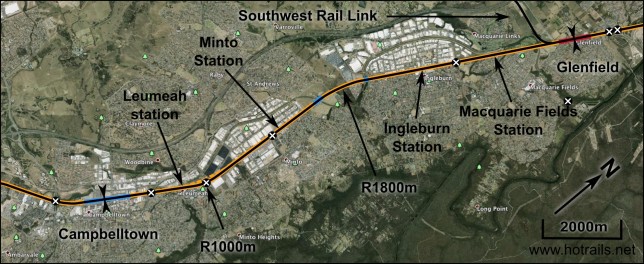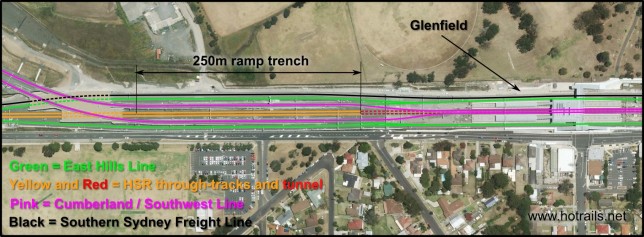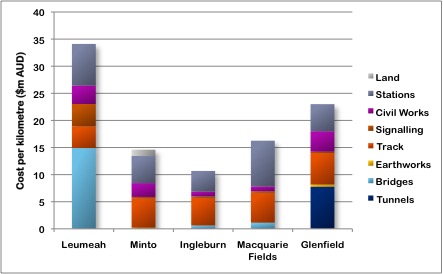← Campbelltown Previous | Next Liverpool →
In the previous post we looked at the difficulties in developing a suitable high-speed corridor into the Sydney CBD. All the options go via Glenfield, so we will look at the Glenfield sector first. The existing rail corridor between Campbelltown and Glenfield was rejected by the 2013 government study due to having insufficiently large radius for their unrealistically fast 400km/h design speed. However, the corridor actually has fairly good geometry, with only two curves of relatively gentle radius; the one at Leumeah has radius 1000m, while the one between Minto and Ingleburn has radius 1800m. This is sufficient for tilting trains to achieve 200km/h; if the first curve were eased to 1800m radius, 250km/h would be achievable.
The main problem is that despite being relatively wide, it is not possible to simply add another pair of high-speed tracks. This is due to the geometry of the existing stations, which are all of the split-platform type with the two suburban lines running straight between them. Additionally, the South Sydney Freight Line runs along the western side, reducing the spare room in the corridor. The best way to solve this is to upgrade the existing suburban lines into the high-speed through-tracks, add new low-speed suburban lines either side, and modify the stations to include extra platforms (this could be done in most cases by modifying existing platforms, but will in any case require a major redevelopment of the stations).
Alignment design
There is very little design work on the corridor itself, being mostly suitable in its current state. The design work will focus on accommodating the high-speed lines with the existing network. As such we expect civil works, station and trackwork costs to be very high in this sector. We will analyse the sector in sections between each station on the line.
It is difficult to forecast what the station modifications would cost, however the works are likely to be significant. A reasonable guess might be in the low tens of millions; note the examples given in the page for station cost estimates. We can also make guesses for each individual construction item required. Solid barriers to protect patrons from high-speed trains would be needed; if we assume these to be similar in construction to noise-attenuation walls, then that’s perhaps $5 million on these walls alone. Guess another $5 million to build new side platforms and perhaps $5m to modify existing structures and that makes $15m a reasonable rough-order estimate of the cost to redevelop the stations along the route.
Leumeah
Campbelltown is a terminal station for the Cumberland and East Hills suburban railway lines, and as such has extensive stabling and turnaround facilities. The only practical way to accommodate the high-speed line is by grade separating it completely from the existing lines. Going over on viaduct is cheaper than going under in tunnel, and less disruptive to existing operations. We’ll allow a kilometre of elevated track (in reality this will extend somewhat back southward of the station itself). Realignment of the tracks here is inevitable, so we will allow a substantial contingency and assume building five tracks: two upgraded, and three brand new. The Moore St overbridge will require widening in order to accommodate the extra tracks. Finally, the platforms at Leumeah Station will require reconfiguration to a central high-speed through-track and two side-platforms to service the suburban trains.
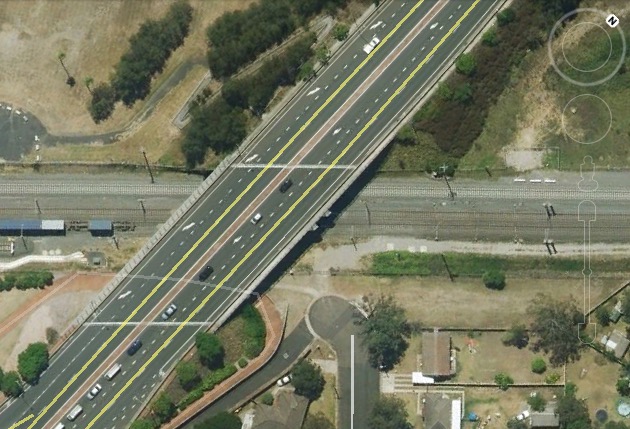
Existing rail corridor at the Moore St overbridge. Image: Google Maps
Minto
Shortly after Leumeah Station we have about 800m of all-new, quintuple track in order to increase the radius of the curve from 1000m to a desirable 1800m – about 3.5ha of land belonging to the open-air car storage facility on Culverston Road will need to be acquired to widen the corridor. The Ben Lomond Road overbridge will probably need to be widened (it is possible that the existing bridge could fit five tracks on the desired alignment as-is, but to be on the safe side we will assume the need for a widening). Minto Station shall be redeveloped in similar fashion to Leumeah.
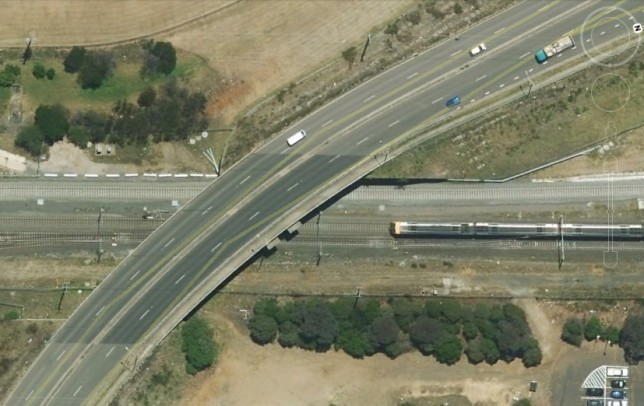
Rail corridor at Ben Lomond Road overbridge, just to the south of Minto Station. Image: Google Maps.
Ingleburn
This section is relatively simple apart from the two crossings of the flood-prone Bow-Bowing Creek. These two bridges are 400m and 80m long, respectively; they are fairly simple culvert-type bridges and inexpensive to construct. Ingleburn Station is located in a wide corridor with ample room for the extra tracks and platforms required.
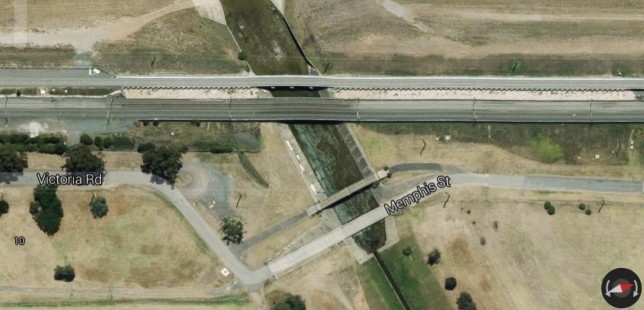
Culvert bridge over Bow Bowing creek, Minto. Image: Google Maps
Macquarie Fields
From Ingleburn to Macquarie Fields is an uncomplicated straight corridor with ample room for an additional two tracks. A small bridge over Redfern Creek near Railway Parade has older, un-utilised piers which could be reinstated for the new tracks.
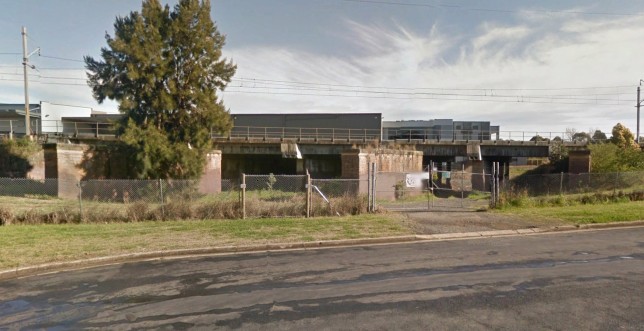
Redfern Creek bridge piers. Image: Google Streetview
Glenfield
The approach to Glenfield is complicated by the joining of the Southwest Rail Line about half a kilometre south of the station. An existing flyover allows grade separation on the main through-lines, however, it subsequently gets highly crowded, with seven tracks immediately north of the flyover leaving almost no extra room in the corridor. At Glenfield Station itself, two island platforms serve four suburban tracks, plus the freight line to the west. Closing platforms 2 and 3 (serving the through-tracks) in order to accommodate HSR would necessitate two additional tracks, and two additional side-platforms, plus realignment of the freight track. There simply isn’t room to do it without substantial rebuilding of the station as well as land acquisitions. The whole precinct was substantially rebuilt anyway in 2012 during the construction of the Southwest Rail Link, so it would be a shame to go and muck it all up.
Simply putting the tracks up on a viaduct is unlikely to work due to the height of of the elevated station building. Diverting this viaduct around the station is likewise impractical due to the long approaches needed to create gentle curves. Therefore the best option is a tunnel beginning about 250m south of the station, soon after the SWRL flyover but before the switching of the SWRL tracks to the through-lines. An additional 250m is allowed for the retained 5m ramp trench down to the tunnel portal. In this way the current configuration of Glenfield Station is retained, with the down-track turnouts merely moved to the south of the SWRL flyover.
Summary
The total cost of the sector is relatively high at $230.0 million ($17.97m/km). This is mainly due to the substantial redevelopment works required on every station along the line in order to accommodate high-speed through-tracks. The cost of these redevelopments was only roughly estimated, so it is possible that the projection may be in error, perhaps by some tens of millions of dollars. Nevertheless, $15m for a platform realignment and some structural modifications to pedestrian walkways strikes the author as a conservative estimate.
The other substantial cost items were the approaches to the two end stations of the sector, the viaduct at Campbelltown and the tunnel at Glenfield. The viaduct cost appears higher than expected as about half of it should strictly speaking be in the previous sector, but it won’t change the outcome. The cost allocated to trackwork is higher than normal due to the requirement to build a quintuple-track alignment. Although expensive fixes, they are worthwhile in that they allow the existing rail corridor to be used, which saves upwards of $50 million per kilometre in tunelling costs.




